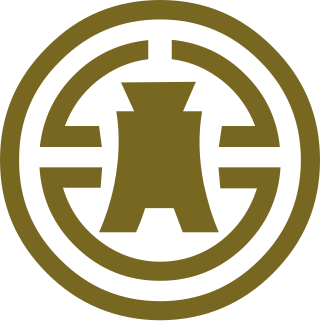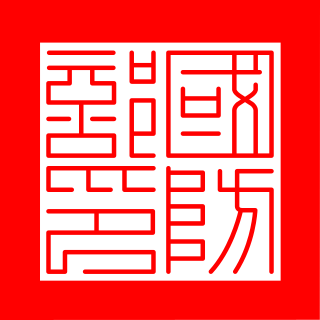| |||||
| Decades: | |||||
|---|---|---|---|---|---|
| See also: | Other events of 1916 History of Taiwan • Timeline • Years | ||||
Events from the year 1916 in Taiwan, Empire of Japan.
| |||||
| Decades: | |||||
|---|---|---|---|---|---|
| See also: | Other events of 1916 History of Taiwan • Timeline • Years | ||||
Events from the year 1916 in Taiwan, Empire of Japan.

Taiwan, officially the Republic of China (ROC), is a country in East Asia. The main island of Taiwan, also known as Formosa, lies between the East and South China Seas in the northwestern Pacific Ocean, with the People's Republic of China (PRC) to the northwest, Japan to the northeast, and the Philippines to the south. It has an area of 35,808 square kilometres, with mountain ranges dominating the eastern two-thirds and plains in the western third, where its highly urbanized population is concentrated. The combined territories under ROC control consist of 168 islands in total covering 36,193 square kilometres. The largest metropolitan area is formed by Taipei, New Taipei City, and Keelung. With around 23.9 million inhabitants, Taiwan is among the most densely populated countries.

The president of the Republic of China (ROC), also known as the president of Taiwan, is the head of state of the Republic of China, commonly known as Taiwan, as well as the commander-in-chief of the Republic of China Armed Forces. Before 1949 the position had the authority of ruling over Mainland China, but after communist victory in the Chinese Civil War, the remaining jurisdictions of the ROC have been limited to Taiwan, Penghu, Kinmen, Matsu, and smaller islands.

Keelung, Chilung or Jilong, officially known as Keelung City, is a major port city situated in the northeastern part of Taiwan. The city is part of the Taipei–Keelung metropolitan area with neighboring New Taipei City and Taipei. Nicknamed the Rainy Port for its frequent rain and maritime role, the city is Taiwan's second largest seaport, and was the world's 7th largest port in 1984.
Vogue may refer to:

The Blue Sky with a White Sun is the national emblem of the Republic of China that covers the period of history in mainland China and Taiwan.

The Bank of Taiwan is a commercial bank headquartered in Taipei, Taiwan. It was established in 1897-1899 as a Japanese policy institution or "special bank", similarly as the Nippon Kangyo Bank, Hokkaido Takushoku Bank, Industrial Bank of Japan, and Bank of Chōsen. Its aim was to finance industrial demand in Japanese-ruled Taiwan and also to promote trade between South China, Southeast Asia and the Japanese possessions in the Pacific.
The General English Proficiency Test is a test of English language proficiency that was commissioned by Taiwan's Ministry of Education in 1999. The GEPT was developed by the Language Training and Testing Center in Taipei, Taiwan and was first administered in 2002.

The Ministry of National Defense of the Republic of China is the ministry of the Republic of China (Taiwan) responsible for all defense and military affairs of Taiwan and surrounding area. The MND is headed by Minister Wellington Koo since 2024.

The Tamsui line or Damtsui line was a railroad branch line located in the cities of Taipei and New Taipei operated by the Taiwan Railways Administration (TRA). It connected the city of Taipei with the town of Tamsui. The route is currently served by the Tamsui–Xinyi line on the Taipei Metro.

The Republic of China calendar, often shortened to the ROC calendar or the Minguo calendar, is a calendar used in Taiwan, Penghu, Kinmen, and Matsu. The calendar uses 1912, the year of the establishment of the Republic of China (ROC) in Nanjing, as the first year.

The 1916–1917 Nantou earthquakes affected central Taiwan in 1916 and 1917, causing heavy damage in sparsely populated Nanto Chō and claiming 71 lives. The strongest quake registered at 6.8 ML and besides the loss of life caused widespread damage to agricultural and forestry industries in central Taiwan.

The Republic of China (ROC) began as a sovereign state in mainland China on 1 January 1912 following the 1911 Revolution, which overthrew the Manchu-led Qing dynasty and ended China's imperial history. From 1927, the Kuomintang (KMT) reunified the country and ruled it as a one-party state and made Nanjing the national capital. In 1949, the KMT-led government was defeated in the Chinese Civil War and lost control of the mainland to the Chinese Communist Party (CCP). The CCP established the People's Republic of China (PRC) while the ROC was forced to retreat to Taiwan and retains control over the "Taiwan Area"; the political status of Taiwan remains in dispute to this day.

Zhuo 224th most common surname in China, shared by 360,000 people (2008). In the Wade–Giles system of romanization, it is romanized as Cho, which is commonly used in Taiwan. The surname is listed 277th in the Song dynasty classic text Hundred Family Surnames.
Ko Hsiang-ting was a Taiwanese actor.
Philosophy in Taiwan is the set of philosophical traditions in Taiwan, while Taiwanese philosophy is taken to mean philosophical work from the country. Philosophical thought in Taiwan is diverse, drawing influence from Chinese philosophy during Qing rule from the 17th and 18th century, and Western philosophy through the Kyoto School during Japanese rule in the 19th and early 20th century. Taiwanese philosophy took a more endogenous turn during the modern era, with burgeoning philosophical debate regarding Taiwanese Gemeinschaft.